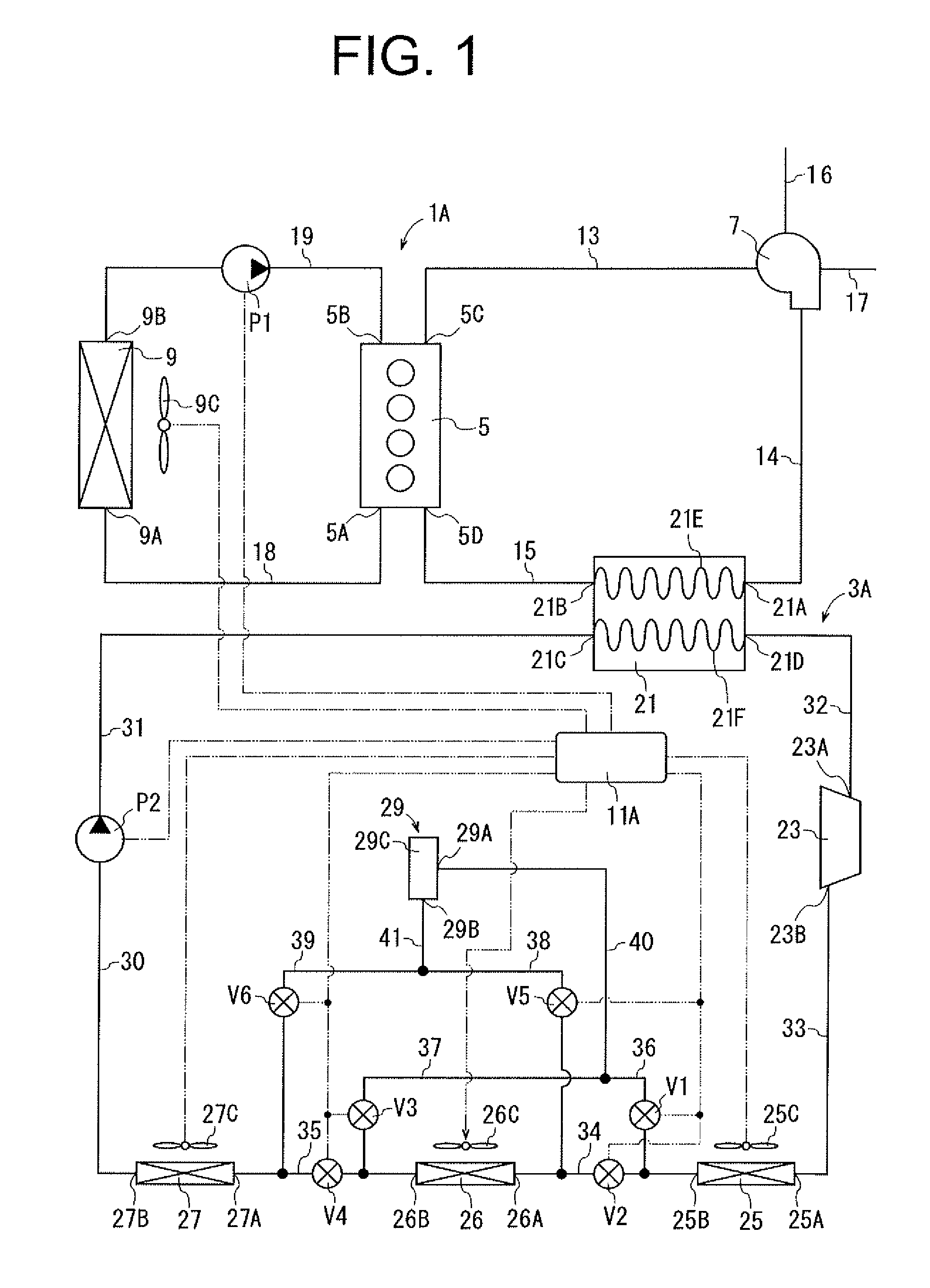Waste heat recovery system
a heat recovery system and waste heat technology, applied in indirect heat exchangers, machines/engines, light and heating apparatus, etc., can solve the problems of reducing the recovery of energy in the rankine cycle device, difficulty in sufficiently cooling the intake fluid, and excessive cooling of the working fluid
- Summary
- Abstract
- Description
- Claims
- Application Information
AI Technical Summary
Benefits of technology
Problems solved by technology
Method used
Image
Examples
first embodiment
[0027]Referring to FIG. 1, the waste heat recovery system of the first embodiment is installed in a vehicle and used with a power unit 1A of the vehicle. The waste heat recovery system includes a Rankine cycle device 3A and a controller 11A. The controller 11A corresponds to the determination device of the present invention.
[0028]The power unit 1A has an internal combustion engine 5, a turbocharger 7 as a forced-induction compressor, and a radiator 9. The engine 5 is a conventional water-cooled gasoline engine having a water jacket (not shown) through which coolant flows. The engine 5 has an inlet 5B and an outlet 5A through which coolant flows into and out of the water jacket. The engine 5 further has an outlet 5C for discharging exhaust gas and an inlet 5D for introducing compressed air.
[0029]The turbocharger 7 and the radiator 9 are of a widely used type. The turbocharger 7 is driven by the exhaust gas exiting the engine 5 to compress the intake air. Compressed air is supplied as...
second embodiment
[0072]In the waste heat recovery system of the second embodiment, if the controller 11A determines that the required output of the engine 5 is low and the required cooling load for the compressed air is below a predetermined threshold, the controller 11A causes the valves V2, V3 to be opened and the valve V1, V4 to be closed, as shown in FIG. 5. Working fluid after being cooled in the first and second heat exchangers 25, 26 flows from the tube 35 into the tube 37, and then enters the second receiver 45 through the inlet 45A. Liquid phase working fluid exiting the second receiver 45 through the outlet 45B flows through the tube 39 into the tube 35, and then enters the third heat exchanger 27 through the inlet 27A. That is, the working fluid exiting the outlet 26B of the second heat exchanger 26 enters the third heat exchanger 27 while bypassing the valve V4 provided in the tube 35. In this case, the first and second heat exchangers 25, 26 function as a condenser, and the third heat e...
third embodiment
[0097]Thus, also the waste heat recovery system of the third embodiment can selectively give priority to increasing the recovery of electric power in the Rankine cycle device 3A or increasing the output of the engine 5.
[0098]FIGS. 10, 11 and 12 show the fourth embodiment of the waste heat recovery system according to the present invention. The fourth embodiment differs from the third embodiment in that a subcool condenser 69 is used instead of the subcool condenser 47 of the third embodiment. An electrically operated fan 69C is provided adjacent to the subcool condenser 69 and electrically connected to the controller 11A.
[0099]As shown in FIGS. 10 and 11, the subcool condenser 69 has vertically extending first and second heads 71, 73, tubes 75A to 75L extending horizontally between the first and the second heads 71, 73, a receiver 77, a piston 79 and a driver 81. The piston 79 and the driver 81 correspond to the volume change device and the selector device of the present invention.
[...
PUM
 Login to View More
Login to View More Abstract
Description
Claims
Application Information
 Login to View More
Login to View More - R&D
- Intellectual Property
- Life Sciences
- Materials
- Tech Scout
- Unparalleled Data Quality
- Higher Quality Content
- 60% Fewer Hallucinations
Browse by: Latest US Patents, China's latest patents, Technical Efficacy Thesaurus, Application Domain, Technology Topic, Popular Technical Reports.
© 2025 PatSnap. All rights reserved.Legal|Privacy policy|Modern Slavery Act Transparency Statement|Sitemap|About US| Contact US: help@patsnap.com



